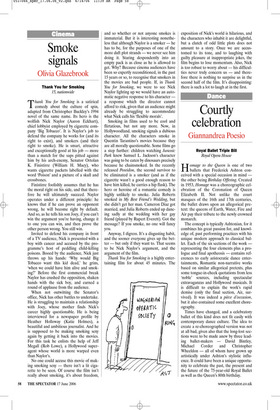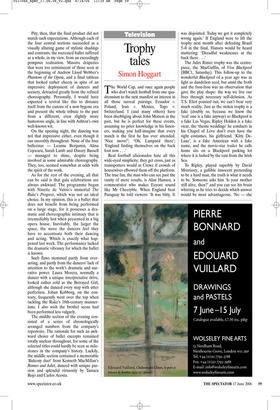Courtly celebration
Giannandrea Poesio
Royal Ballet Triple Bill Royal Opera House Homage to the Queen is one of two ballets that Frederick Ashton conceived with a special occasion in mind the other being Birthday Offering. Created in 1953, Homage was a choreographic celebration of the Coronation of Queen Elizabeth II. Not unlike the court masques of the 16th and 17th centuries, the ballet draws upon an allegorical pretext: the queens of Earth, Water, Fire and Air pay their tribute to the newly crowned monarch.
The concept is typically Ashtonian, for it combines his great passion for, and knowledge of, past performing practices with his unique modern approach to classical ballet. Each of the six sections of the work representing the four elements plus a prologue and final apotheosis — contains references to early aristocratic dance entertainments, Romantic non-narrative works based on similar allegorical pretexts, plus some tongue-in-cheek quotations from less ‘noble’ sources, including spectacular extravaganzas and Hollywood musicals. It is difficult to explain the work’s rapid demise (only the final section, Air, survived). It was indeed a pièce d’occasion, but it also contained some excellent choreography.
Times have changed, and a celebratory ballet of this kind does not fit easily with contemporary dance culture. The idea to create a re-choreographed version was not at all bad, given also that the long-lost sections were to be made anew by three leading ballet-makers — David Bintley, Michael Corder and Christopher Wheeldon — all of whom have grown up artistically under Ashton’s stylistic influence. It could have been a unique opportunity to celebrate the past, the present and the future of the 75-year-old Royal Ballet as well as the Queen’s 80th birthday. Pity, then, that the final product did not match such expectations. Although each of the four central sections succeeded as a visually alluring game of stylistic shadings and contrasts, the recreated ballet suffered as a whole, in my view, from an exceedingly pompous realisation. Massive draperies that were too reminiscent of those seen at the beginning of Andrew Lloyd Webber’s Phantom of the Opera, and a final tableau that looked rather cheesy in spite of an impressive deployment of dancers and scenery, detracted greatly from the refined choreography. Personally, I would have expected a revival like this to distance itself from the canons of a now bygone era and present the whole tribute to the past from a different, even slightly more humorous angle, in line with Ashton’s own well-known wit.
On the opening night, the dancing was not that impressive either, even though it ran smoothly throughout. None of the four ballerinas — Leanne Benjamin, Alina Cojocaru, Sarah Lamb and Darcey Bussell — managed to shine, despite being involved in some admirable choreography. They, too, seemed somewhat at odds with the spirit of the work.
As for the rest of the evening, all that can be said is that gala celebrations are always awkward. The programme began with Ninette de Valois’s immortal The Rake’s Progress, which was not an ideal choice. In my opinion, this is a ballet that does not benefit from being performed on a large stage, for it possesses a dramatic and choreographic intimacy that is irremediably lost when presented in a big opera house. Inevitably, the larger the space, the more the dancers feel they have to accentuate both their dancing and acting. Which is exactly what happened last week. The performance lacked the dramatic vibrancy for which the ballet is known.
Such flaws stemmed partly from overacting, and partly from the dancers’ lack of attention to the work’s dramatic and narrative power. Laura Morera, normally a dancer with a unique interpretative drive, looked rather cold as the Betrayed Girl, although she danced every step with utter perfection. Johan Kobborg, on the contrary, frequently went over the top when tackling the Rake’s 18th-century mannerisms. I also wish the brothel scene had been performed less vulgarly.
The middle section of the evening consisted of a series of chronologically arranged numbers from the company’s repertoire. The rationale for such an awkward choice of ballet excerpts remained totally unclear throughout, for some of the selected titles could hardly be seen as milestones in the company’s history. Luckily, the middle section contained a memorable ‘Balcony duet’ from Kenneth MacMillan’s Romeo and Juliet, danced with unique passion and splendid virtuosity by Tamara Rojo and Carlos Acosta.



















































































 Previous page
Previous page